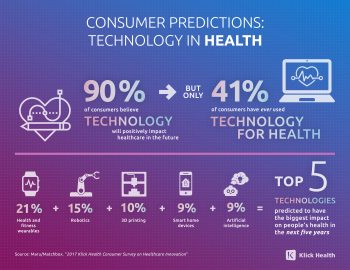 U.S. consumers consider Consumer Electronics to be the most innovative industry they know. But people believe that Health & Wellness should be the most innovative sector in the economy.
U.S. consumers consider Consumer Electronics to be the most innovative industry they know. But people believe that Health & Wellness should be the most innovative sector in the economy.
Welcome to the 2017 Klick Health Consumer Survey, which focuses on health innovation in the context of peoples’ hopes for technology to improve health and healthcare.
1 in 2 people say that technology has had a positive impact on their health and wellness, skewing slightly more toward younger people (although 45% of people 55 years of age and older agree that tech positively contributes to health.
41% of consumers say they’ve personally used technology for health, with more men (43%) than women (39%) and more younger people (60% of those 18-34) versus older people (21% of folks 55+) having used tech for health.
7 in 10 consumers say technology will help them personally manage health, helping them stay healthy (24%), better manage a condition (15%), prevent disease (14%), and help physicians provider earlier diagnoses (14%).
Nearly 50% of consumers believe that creative innovation in healthcare will lead to better treatment and diagnoses in the next five years, such as helping physicians better treat patients, prevent disease, help patients better manage their own health, and improve disease diagnoses.
The technologies consumers say will most likely have a big impact on their health in the next five years are:
- Health and fitness wearables (21%) [one of the only categories for which more older consumers 55+ are bullish]
- Robotics (15%)
- 3-D printing (10%)
- Smart home devices (9%)
- Artificial intelligence (9%), and
- Mobile apps (8%).
Only 4% of consumers anticipate that voice-controlled devices (such as Amazon’s Alexa) will have a big impact on health over the next five years.
The Klick survey was conducted in May 2017 among 1,012 U.S. adults who are members of the Springboard America Community panel.
Health Populi’s Hot Points: U.S. consumers are ready to more deeply adopt technology-based healthcare solutions to prevent, diagnose, and manage medical issues in their daily lives, the Klick survey found.
But there’s more: people aren’t just keen to take on more DIY, self-care roles in health and wellness; consumers also see more opportunity for health engagement with their physicians and other healthcare providers underpinned by technologies, such as wearables, robotics, and smart home devices.
It’s important to call out the segment of smart home and voice-activated devices, which have experienced a relatively quick adoption among general consumers in the home. Consumers aren’t yet connecting the dots between Alexa and her competitors as platforms for health engagement. This is an opportunity for tech-based consumer health engagement to grow for people managing conditions at home about which the majority of American consumers are largely unaware.
There is a broader opportunity, as well, for the digital health industry, writ large, to inform health consumers about the growing portfolio of tech products that people can access for personal health management that go way beyond the wristband. A greater focus on the role, benefits and uses of personal health data will help all boats serving the consumer health-tech market rise, regardless of the devices’ form factors.
And then there’s the design aspect of digital health devices. More younger people see innovation in the media and entertainment industry. What magic might happen in Health & Wellness developers recruited from the likes of Disney, CNN, or Dreamworks? That’s the kind of place my colleague Roger Holzberg came from before he entered healthcare, and he’s making magic bringing that enchanting design ethos to his work at Reimagine Well.




 Thank you FeedSpot for
Thank you FeedSpot for